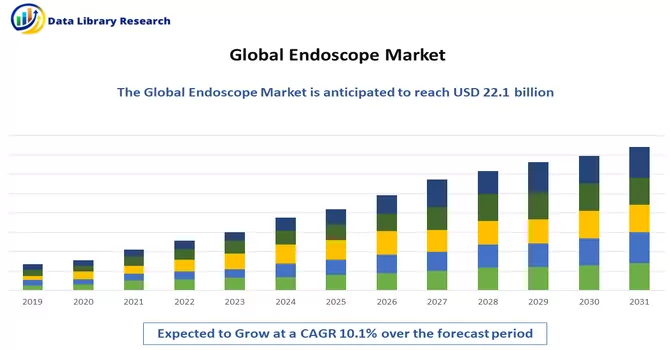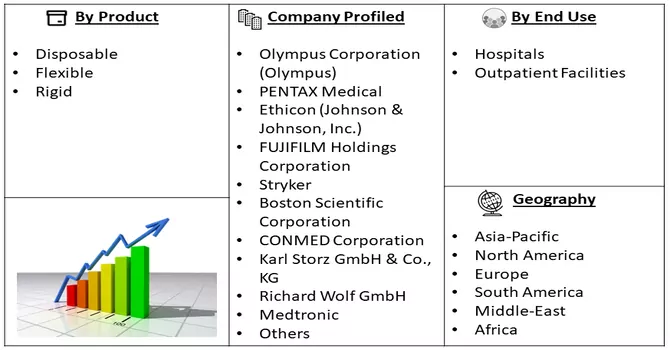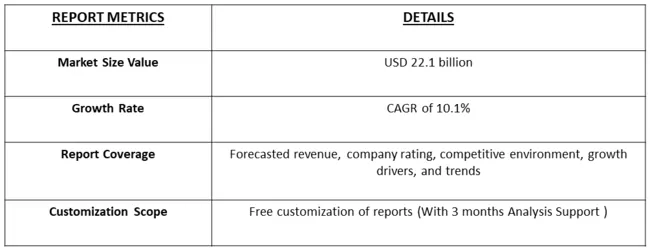The global endoscopes market size was valued at USD 22.1 billion in 2023 and is expected to grow at a compound annual growth rate (CAGR) of 10.1% from 2024 to 2030.

Get Complete Analysis Of The Report - Download Free Sample PDF
The endoscopes market is witnessing significant growth driven by advancements in technology, increasing prevalence of gastrointestinal diseases, and rising demand for minimally invasive procedures. Endoscopes are vital tools used in diagnostic and therapeutic procedures across various medical specialties such as gastroenterology, urology, gynecology, and orthopedics. The market is characterized by continuous innovation, with manufacturers focusing on developing endoscopes with enhanced imaging capabilities, better ergonomics, and improved patient comfort. Moreover, the growing geriatric population, coupled with the rising incidence of chronic diseases, has fueled the demand for endoscopic procedures for early detection and treatment.
Additionally, the shift towards outpatient settings and the preference for minimally invasive surgeries have further boosted the adoption of endoscopic procedures, driving the growth of the endoscopes market globally. The growth of the endoscopes market is primarily driven by several factors including technological advancements, increasing prevalence of gastrointestinal diseases, rising demand for minimally invasive procedures, and expanding applications across various medical specialties. Technological innovations have led to the development of advanced endoscopic devices with enhanced imaging capabilities, better maneuverability, and improved patient comfort, thereby driving their adoption in diagnostic and therapeutic procedures. Additionally, the growing prevalence of gastrointestinal diseases such as colorectal cancer, gastrointestinal bleeding, and inflammatory bowel disease has increased the demand for endoscopic examinations for early detection and treatment. Moreover, the rising geriatric population, coupled with the increasing awareness about the benefits of minimally invasive surgeries, has further propelled the demand for endoscopic procedures globally, contributing to the growth of the endoscopes market.
Market Segmentation: Endoscopes Market is Segmented By Product (Disposable, Flexible, Rigid), End Use (Hospitals, and Outpatient Facilities) and Geography (North America, Europe, Asia-Pacific, Middle East and Africa, and South America). The report offers the value (in USD million) for the above segments.

For Detailed Market Segmentation - Download Free Sample PDF
The endoscopes market is witnessing several notable trends that are shaping its landscape. One significant trend is the increasing adoption of minimally invasive procedures. Minimally invasive endoscopic procedures offer several advantages over traditional surgical techniques, including reduced patient discomfort, shorter recovery times, and lower risk of complications. As a result, there is a growing preference for endoscopic procedures among patients and healthcare providers alike. Additionally, technological advancements such as the development of flexible and disposable endoscopes, as well as the integration of artificial intelligence and robotic-assisted systems, are further enhancing the capabilities and accessibility of endoscopic procedures. Another notable trend is the expanding applications of endoscopy beyond gastrointestinal disorders. Endoscopic techniques are increasingly being used in specialties such as urology, gynecology, pulmonology, and ENT (ear, nose, and throat) surgery, driving market growth by expanding the addressable market and increasing procedure volumes. Moreover, the growing emphasis on preventive healthcare and early disease detection is driving the demand for screening and surveillance endoscopic procedures, particularly for conditions such as colorectal cancer and Barrett's esophagus. Overall, these trends underscore the dynamic nature of the endoscopes market and its evolving role in modern healthcare.
Market Drivers:
Technological Advancements:
Ongoing technological advancements in endoscopic imaging, visualization, and navigation systems are driving market growth. Innovations such as high-definition imaging, narrow-band imaging, 3D imaging, and fluorescence imaging are improving the accuracy and effectiveness of endoscopic procedures. These advancements enable healthcare professionals to perform more precise diagnostic and therapeutic interventions, leading to better patient outcomes and increased adoption of endoscopic procedures.
Increasing Prevalence of Gastrointestinal Disorders:
The rising prevalence of gastrointestinal disorders, such as gastrointestinal cancers, gastroesophageal reflux disease (GERD), inflammatory bowel disease (IBD), and gastrointestinal bleeding, is fueling the demand for endoscopic procedures. Endoscopy is widely used for the diagnosis, staging, and treatment of various gastrointestinal conditions. As the incidence of these disorders continues to rise globally, particularly due to factors like aging populations and changing lifestyles, the demand for endoscopic procedures is expected to grow significantly, thereby driving the growth of the endoscopes market.
Market Restraints:
Despite its promising growth prospects, the endoscopes market also faces several significant restraints that could impede its expansion. One primary restraint is the high cost associated with endoscopic procedures and equipment. The initial investment required for purchasing endoscopes and associated accessories, as well as the recurring expenses for maintenance, sterilization, and training, can be substantial for healthcare facilities, particularly in emerging economies with limited healthcare budgets. Additionally, reimbursement challenges and stringent regulatory requirements for endoscopic procedures may hinder market growth, as they can create barriers to adoption and limit patient access to endoscopic services. Furthermore, concerns regarding patient safety, such as the risk of infection transmission and adverse events associated with endoscopic procedures, may lead to reluctance among patients and healthcare providers, affecting procedure volumes and market demand. Lastly, the lack of skilled endoscopists and trained personnel in certain regions may pose challenges to the widespread adoption of endoscopic techniques, especially in rural and underserved areas. Addressing these market restraints will be crucial for unlocking the full potential of the endoscopes market and ensuring its sustained growth in the future.
The COVID-19 pandemic has had a mixed impact on the endoscopes market. On one hand, the postponement or cancellation of elective procedures during the peak of the pandemic led to a decline in endoscopic procedures, affecting market revenues negatively. Healthcare facilities diverted resources and attention towards managing COVID-19 patients, resulting in reduced demand for non-urgent endoscopic procedures. Additionally, concerns about infection transmission among patients and healthcare workers further contributed to the decline in endoscopy volumes. However, as healthcare systems gradually resumed elective procedures and adapted to the new normal, there has been a resurgence in endoscopic activities. The backlog of postponed procedures, coupled with the increasing adoption of telemedicine and remote monitoring, has driven demand for endoscopic services. Moreover, the emphasis on infection control measures and the implementation of stringent sterilization protocols have underscored the importance of high-quality endoscopic equipment and accessories, driving investments in advanced endoscope technologies. Looking ahead, the COVID-19 pandemic is expected to accelerate the adoption of innovative endoscopic solutions and reshape the landscape of the endoscopes market, with a greater focus on safety, efficiency, and infection prevention.
Segmental Analysis:
Disposable Endoscope Segment is Expected to Witness Growth Over the Forecast Period
The disposable endoscope market is experiencing significant growth due to several factors driving its adoption in healthcare settings. Disposable endoscopes offer several advantages over traditional reusable endoscopes, including reduced risk of infection transmission, elimination of reprocessing costs, and improved efficiency in clinical workflows. One of the key drivers of the growing use of disposable endoscopes is the increasing focus on infection control and prevention in healthcare facilities. Reusable endoscopes require thorough cleaning and sterilization after each use, which can be challenging and time-consuming. In contrast, disposable endoscopes are single-use devices that are discarded after a single procedure, eliminating the risk of cross-contamination and the need for reprocessing. Another factor driving the growth of the disposable endoscope market is the increasing demand for minimally invasive procedures. Disposable endoscopes are well-suited for minimally invasive procedures due to their flexibility, ease of use, and ability to provide high-quality imaging. As the number of minimally invasive procedures continues to rise, so does the demand for disposable endoscopes. Additionally, technological advancements in disposable endoscope design and manufacturing have improved their performance and reliability, further driving their adoption. Disposable endoscopes are now available in a variety of types and sizes, making them suitable for a wide range of procedures across various medical specialties. The growing use of disposable endoscopes is expected to continue as healthcare facilities seek to improve infection control practices, enhance patient safety, and streamline clinical workflows. However, challenges such as cost considerations and environmental impact may influence the pace and extent of adoption in different healthcare settings.
Outpatient Facilities Segment is Expected to Witness Growth Over the Forecast Period
Outpatient facilities play a crucial role in the endoscope market, particularly concerning the use of disposable endoscopes. These facilities, which include ambulatory surgery centers (ASCs), clinics, and physician offices, are increasingly adopting disposable endoscopes due to their convenience, cost-effectiveness, and infection control benefits. The key drivers for the use of disposable endoscopes in outpatient facilities is the need for efficient and streamlined procedures. Disposable endoscopes eliminate the need for reprocessing, which can save time and resources for outpatient facilities that often have limited staff and equipment compared to hospitals. Additionally, disposable endoscopes can help reduce the risk of infections, which is especially important in outpatient settings where patients may be more vulnerable to infections due to shorter recovery times and less stringent infection control measures compared to hospitals. Furthermore, the use of disposable endoscopes aligns with the trend towards minimally invasive procedures in outpatient settings. Disposable endoscopes are well-suited for minimally invasive procedures due to their flexibility, ease of use, and ability to provide high-quality imaging. As outpatient facilities continue to perform more minimally invasive procedures, the demand for disposable endoscopes is expected to rise. Despite these advantages, the adoption of disposable endoscopes in outpatient facilities may be hindered by cost considerations. Disposable endoscopes can be more expensive upfront compared to reusable endoscopes, which may deter some outpatient facilities from making the switch. However, the long-term cost savings and infection control benefits of disposable endoscopes may outweigh the initial investment for many outpatient facilities. Thus, outpatient facilities are a key market segment for the endoscope market, particularly for disposable endoscopes. As these facilities continue to grow in importance in the healthcare landscape, the demand for disposable endoscopes is expected to increase, driving growth in the market.
North America Region is Expected to Witness Growth Over the Forecast Period
The North America region is a significant market for endoscopes, driven by several factors including the high prevalence of gastrointestinal diseases, advanced healthcare infrastructure, and the presence of key market players. Endoscopes are widely used in North America for diagnostic and therapeutic purposes across various medical specialties, including gastroenterology, pulmonology, and urology. One of the key drivers of the endoscope market in North America is the high prevalence of gastrointestinal diseases such as colorectal cancer, inflammatory bowel disease, and gastroesophageal reflux disease (GERD). Endoscopy is commonly used for the diagnosis and management of these conditions, driving the demand for endoscopes in the region. Additionally, the advanced healthcare infrastructure in North America, including a high number of hospitals, ambulatory surgery centers (ASCs), and specialty clinics, contributes to the growth of the endoscope market. These facilities are equipped with state-of-the-art endoscopic equipment and are staffed by skilled healthcare professionals, further driving the adoption of endoscopic procedures. Furthermore, the presence of key market players in North America, including manufacturers, distributors, and service providers, contributes to the growth of the endoscope market. These companies invest in research and development to develop innovative endoscopic technologies and expand their product offerings, driving market growth.However, the endoscope market in North America faces challenges such as high costs associated with endoscopic procedures and equipment, as well as reimbursement issues. Despite these challenges, the North America region is expected to remain a key market for endoscopes due to the high demand for minimally invasive procedures and the increasing adoption of advanced endoscopic technologies.

Get Complete Analysis Of The Report - Download Free Sample PDF
The analyzed market exhibits a high degree of fragmentation, primarily attributable to the presence of numerous players operating on both a global and regional scale. The competitive landscape is characterized by a diverse array of companies, each contributing to the overall market dynamics. This fragmentation arises from the existence of specialized solution providers, established industry players, and emerging entrants, all vying for market share. The diversity in market participants is underscored by the adoption of various strategies aimed at expanding the company presence. On a global scale, companies within the studied market are strategically positioning themselves through aggressive expansion initiatives. This often involves entering new geographical regions, targeting untapped markets, and establishing a robust global footprint. The pursuit of global expansion is driven by the recognition of diverse market opportunities and the desire to capitalize on emerging trends and demands across different regions. Simultaneously, at the regional level, companies are tailoring their approaches to align with local market dynamics. Regional players are leveraging their understanding of specific market nuances, regulatory environments, and consumer preferences to gain a competitive edge. This regional focus allows companies to cater to the unique needs of local clientele, fostering stronger market penetration. To navigate the complexities of the fragmented market, companies are implementing a range of strategies. These strategies include investments in research and development to stay at the forefront of technological advancements, mergers and acquisitions to consolidate market share, strategic partnerships for synergies, and innovation to differentiate products and services. The adoption of such multifaceted strategies reflects the competitive nature of the market, with participants continually seeking avenues for growth and sustainability. In essence, the high fragmentation in the studied market not only signifies the diversity of players but also underscores the dynamism and competitiveness that drive ongoing strategic maneuvers. As companies explore various avenues for expansion, the market continues to evolve, presenting both challenges and opportunities for industry stakeholders.
Key Endoscopes Companies:
Recent Development:
1) In November 2023, Olympus Corporation introduced its latest endoscopy system, the EVIS X1, in China. This cutting-edge system was showcased at the 6th annual China International Import Expo in Shanghai, held from November 5th to 10th. The EVIS X1 represents a significant advancement in endoscopic technology, offering improved imaging capabilities and enhanced features for more precise diagnostic and therapeutic procedures.
2) In March 2023, AIG Hospitals in Hyderabad unveiled a Center of Excellence (CoE) established in partnership with Boston Scientific. This collaboration aims to elevate healthcare services by providing access to advanced treatment options and specialized expertise across various medical disciplines. The CoE will focus on delivering high-quality care, fostering innovation, and advancing medical research to benefit patients in Hyderabad and beyond.
Q1. What was the Endoscope Market size in 2023?
As per Data Library Research the global endoscopes market size was valued at USD 22.1 billion in 2023.
Q2. At what CAGR is the Endoscope Market projected to grow within the forecast period?
Endoscope Market is expected to grow at a compound annual growth rate (CAGR) of 10.1% over the forecast period.
Q3. What are the Growth Drivers of the Endoscope Market?
Technological Advancements and Increasing Prevalence of Gastrointestinal Disorders are the Growth Drivers of the Endoscope Market.
Q4. Which region has the largest share of the Endoscope Market? What are the largest region's market size and growth rate?
North America has the largest share of the market. For detailed insights on the largest region's market size and growth rate request a sample here.
Data Library Research are conducted by industry experts who offer insight on industry structure, market segmentations technology assessment and competitive landscape (CL), and penetration, as well as on emerging trends. Their analysis is based on primary interviews (~ 80%) and secondary research (~ 20%) as well as years of professional expertise in their respective industries. Adding to this, by analysing historical trends and current market positions, our analysts predict where the market will be headed for the next five years. Furthermore, the varying trends of segment & categories geographically presented are also studied and the estimated based on the primary & secondary research.
In this particular report from the supply side Data Library Research has conducted primary surveys (interviews) with the key level executives (VP, CEO’s, Marketing Director, Business Development Manager and SOFT) of the companies that active & prominent as well as the midsized organization
FIGURE 1: DLR RESEARH PROCESS

Extensive primary research was conducted to gain a deeper insight of the market and industry performance. The analysis is based on both primary and secondary research as well as years of professional expertise in the respective industries.
In addition to analysing current and historical trends, our analysts predict where the market is headed over the next five years.
It varies by segment for these categories geographically presented in the list of market tables. Speaking about this particular report we have conducted primary surveys (interviews) with the key level executives (VP, CEO’s, Marketing Director, Business Development Manager and many more) of the major players active in the market.
Secondary ResearchSecondary research was mainly used to collect and identify information useful for the extensive, technical, market-oriented, and Friend’s study of the Global Extra Neutral Alcohol. It was also used to obtain key information about major players, market classification and segmentation according to the industry trends, geographical markets, and developments related to the market and technology perspectives. For this study, analysts have gathered information from various credible sources, such as annual reports, sec filings, journals, white papers, SOFT presentations, and company web sites.
Market Size EstimationBoth, top-down and bottom-up approaches were used to estimate and validate the size of the Global market and to estimate the size of various other dependent submarkets in the overall Extra Neutral Alcohol. The key players in the market were identified through secondary research and their market contributions in the respective geographies were determined through primary and secondary research.
Forecast Model
